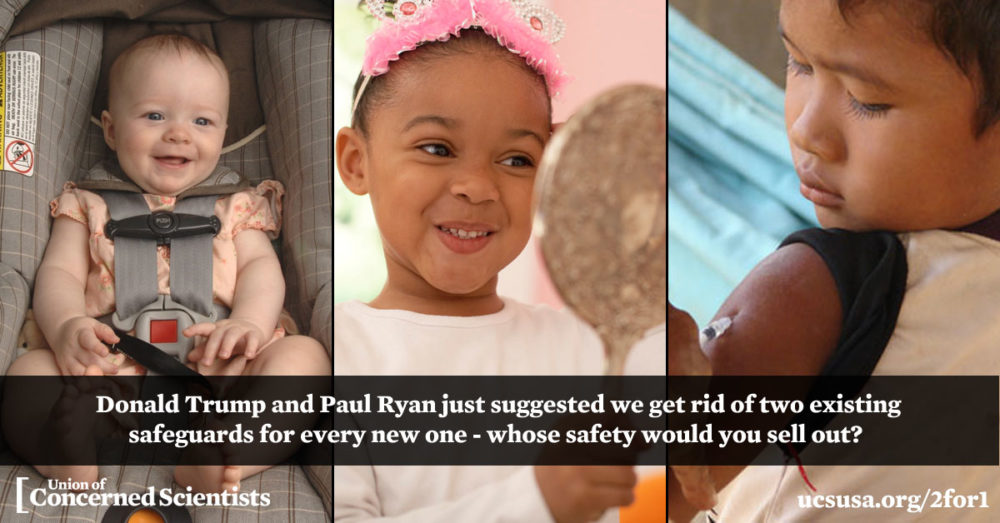UPDATE (January 30, 2017): President Donald Trump has signed a reckless executive order requiring agencies to cut two rules for every new one issued. Read our response.
The President-elect recently described in a Youtube video what he intends to do on his very first day in office. Among other things, he will issue a new command to all federal agencies: “if you want to issue a new regulation, you must repeal two existing ones.”
So, for example, if the Environmental Protection Agency (EPA) wants to issue a new rule to protect kids from mercury pollution from power plants, it would need to cut two existing rules, such as reducing lead in drinking water or requiring school buses to cut smog-causing emissions. Or if the Consumer Product Safety Commission wants to protect families from dangerous car seats for children, the Commission would need to drop rules such as requiring better labeling of age appropriate toys, or reducing toxic substances in baby products.
As these examples illustrate, the idea is absurd. Agencies issue multiple regulations because there are multiple threats to public health, safety, and the environment. Each regulation must be judged on its own merits. If a new regulation is warranted, it should be issued. If an existing regulation is outdated or no longer effective, it should be changed. One shouldn’t be held hostage for the other.
The idea is also illegal. An agency’s authority to issue regulations comes from statutes passed by Congress, and these statutes do not place a “cap” on regulations. For example, Congress has mandated that the Food and Drug Administration regulate a wide array of products that we consume. But with this “two for one” rule in place, the FDA will have to limit the total number of regulations, and make arbitrary choices between protecting the public from one health threat versus another. Such choices will inevitably put agencies in a position where they are violating the statutes that empower them.
What propels this idea forward? Perhaps it is that when viewed cumulatively, regulations impose a noticeable cost on businesses, workers, and consumers. But as Oliver Wendell Holmes once said about taxes, that cost is the price of living in a civilized society. To see what life would be like if we didn’t pay these costs, go visit cities such as Beijing and Delhi where millions put their health at risk merely by taking a walk outside. Or, much closer to home, visit Flint Michigan, where the proper Safe Drinking Water Act standards were in place, but not enforced.
The “two for one” concept also shows a lack of understanding of how regulations are issued. Agencies are already required to take costs into account. If regulation opponents believe that an agency has sidestepped this requirement, they can sue, and courts can and do strike down regulations when agencies don’t follow this rule. As a former regulator, I spent many hours trying to ensure that actions were clearly within the statutory authorities set by the legislative branch.
Supporters of this rule may claim it is needed because once regulations get on the books, agencies lack an incentive to review and update them. But if this is the purpose of the “two for one rule,” Mr. Trump is using a bludgeon when a scalpel would work better. The President-elect could look to the far better alternative of requiring agencies to conduct periodic reviews of regulations.
In Massachusetts, for example, where I served as Commissioner of the Department of Environmental Protection (DEP), we complied with a state streamlining law by convening a stakeholder group representing business, municipalities and environmental groups to identify regulations that could be cut or modified. We also empowered the agency staff—who sometimes know best what works and what doesn’t—to offer suggestions as well. And we found funding to upgrade our IT systems to make regulatory compliance more like using turbo tax and less like reading the tax code.
The result: we modified or cut hundreds of regulations that were no longer best serving their intended purpose, and we did so without lowering the standards for protection of public health, safety, or the environment.
President-elect Trump is not off to a good start with this proposal. If he truly wants to help “forgotten Americans,” as he has proclaimed, he should allow federal agencies to continue to protect their health and safety. Two for one proposals make a good sound bite, but not sensible public policy.

